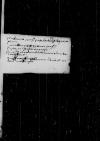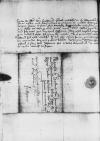Valde miror, quod hactenus non scripseritis, cum praesertim tot sese ad id faciendum obtulerint occasiones. Ego enim ad vos subinde per mercatores transmisi litteras[1] et si ad vos, id quod spero, advenerit salvus dominus ⌊Udalrichus Eyngher⌋, tametsi sine meis ad vos litteris abierit, referre tamen potuit, quae me concernebant. Cum ad vos iter pararent oratores illustrissimae ⌊dominae Marguarythae⌋, ⌊⌋ tum, quantumvis non copiose, non enim satis mihi persuaseram litteras ad vos eas perventuras esse. Si vero praeter spem meam vos earundem orig. earumdem⌈earundemearundem orig. earumdem⌉ potiti estis, longe mihi ex animo res ea gratissima est, sin minus, parva iactura est, dummodo sciatis animum eundem orig. eumdem⌈eundemeundem orig. eumdem⌉ esse.
Nolo nunc multa tibi scribere de successu rerum mearum in ⌊Polonia⌋,[2] quaque me humanitate exceperint ⌊principes tui⌋, quamque ego de illis relationem[3] apud serenissimum ⌊regem dominum Ferdinandum⌋ fecerim, quae denique ad sacram ⌊caesaream maiestatem⌋ transcripserim. Haec enim malo, ut ex me aliquando praesens orig. presens⌈praesenspraesens orig. presens⌉ intelligas, modo praesentia tua frui posse mihi aliquando concedant superi.
Nunc solum cuperem de rebus vestris certior fieri, audio enim insignem mutationem factam istic orig. isthic⌈isticistic orig. isthic⌉ esse. De Lalmanto encrypted ⌈⌊Lalmanto⌋Lalmanto encrypted ⌉[4] enim nescio, an vere orig. vaere⌈verevere orig. vaere⌉ multa hic dicantur. Maltensis encrypted ⌈⌊Maltensis⌋Maltensis encrypted ⌉[5] non omnino hic etiam bene audit. Credo haec prudentia cancellarii patefacta esse, de quo cuperem encrypted ⌈prudentia ⌊cancellarii⌋[6] patefacta esse, de quo cuperemprudentia cancellarii patefacta esse, de quo cuperem encrypted ⌉,[7] multa ut scriberes, nam ego impeditus sum hic in negotio orig. negocio⌈negotionegotio orig. negocio⌉ serenissimi ⌊domini Ferdinandi⌋ et tempestatibus his ad navigandum tam inidoneis demens sum, si me commisero. Hic enim validissimus ventus fuit continuus per quinque hebdomadas, quo non est visus auditusve maior memoria hominum. Profecto ego, cum ex ⌊Flandria⌋ traicerem orig. traiicerem⌈traiceremtraicerem orig. traiicerem⌉ in ⌊Zelandiam⌋, qui traiectus unum miliare patet, hodie 32-s dies agitur, numquam tam prope fui, ut perirem cum ⌊uxore mea⌋ et familia, viginti quatt paper damaged⌈[t]t paper damaged⌉uor horis distentus in mari amissa malo arbore, quam  AAWO, AB, D.3, f. 23v unicam navicula traiectoria habebat, veloque et rudentibus in mare proiectis, adhaec amisso gubernaculo orig. gubernaclo⌈gubernaculogubernaculo orig. gubernaclo⌉, cum terra potiundi nobis potestas nulla fieret. Hoc me cautiorem facit et puto tibi a me significatum fuisse, quo tempore iter ⌊huc⌋ parabam ex ⌊Hispaniis⌋, aditum quidem bonum, sed reditum perquam periculosum futurum – id, quod nunc accidit. Exspectabo ergo anni tempus minus his malis subiectum. Et tu interea sive mari, sive terra reditum tuum adornas, noli facere, ut de hoc incertus sim.
AAWO, AB, D.3, f. 23v unicam navicula traiectoria habebat, veloque et rudentibus in mare proiectis, adhaec amisso gubernaculo orig. gubernaclo⌈gubernaculogubernaculo orig. gubernaclo⌉, cum terra potiundi nobis potestas nulla fieret. Hoc me cautiorem facit et puto tibi a me significatum fuisse, quo tempore iter ⌊huc⌋ parabam ex ⌊Hispaniis⌋, aditum quidem bonum, sed reditum perquam periculosum futurum – id, quod nunc accidit. Exspectabo ergo anni tempus minus his malis subiectum. Et tu interea sive mari, sive terra reditum tuum adornas, noli facere, ut de hoc incertus sim.
⌊Ioannem Levicium⌋ satis credo apud te esse, si modo adhuc in ⌊Hispaniis⌋ agis. Ideoque reor non tantum nunc esse, quod agas. Rogo te, ut copiose rescribas ad me, quo in me sit animo cancellarius, encrypted ⌈quo in me sit animo ⌊cancellarius⌋,[8]quo in me sit animo cancellarius, encrypted ⌉ et an caesar in Italiam iturus sit encrypted ⌈⌊caesar⌋[9] in ⌊Italiam⌋[10] iturus sitcaesar in Italiam iturus sit encrypted ⌉.[11] Ego enim eo ex nuntio orig. nuncio⌈nuntionuntio orig. nuncio⌉ consilium caperem, quid factu esset optimum. ⌊Angli⌋ ⌊Franci⌋que[12] passim regem Poloniae encrypted ⌈⌊regem Poloniae⌋regem Poloniae encrypted ⌉[13] secum foedere iunctum esse favereque ⌊Ioanni vayevodae⌋.[14] Ego vero, quamquam id omnino falsum esse scio, vix tamen id possum nostris persuadere. ⌊Ioannes Statidius(!)⌋ praepositus orig. prepositus⌈praeposituspraepositus orig. prepositus⌉ Budensis, qui ⌊vayevodae⌋ orator apud ⌊Gallum⌋ ⌊Anglum⌋que fuit, secreto itinere creditur rediisse in ⌊P written over ...⌈... illegible⌈...... illegible⌉PP written over ...⌉oloniam⌋ ad vayevodam.
⌊Hoochsteterorum⌋[15] primarius mercator apud superinscribed⌈apudapud superinscribed⌉ ⌊regem Angliae⌋ gratiosus ab eo missus est ad serenissimum ⌊regem Ferdinandum⌋ orator iussusque dicere, si idem rex Ferdinandus ea oppida, quorum nunc potitur ⌊vayevoda⌋, in eius potestate esse permittere velit, se ⌊Francumque regem⌋ quater centena milia aureorum ad bellum Turcicum eidem transmissurum esse, sin minus, eam se(?) summam ad vayevodam perventuram. Nondum constat, quid Ferdinandus responderit.
Conventus principum Germanorum[16] indictus est ⌊Spiram⌋. Cui et ⌊Ferdinandum⌋ interfuturum fama est. Quid agat reverendus ⌊dominus Maltensis⌋, incertus sum, fructum tamen commissionum tam magnificarum adhuc video esse perquam exiguum. Nos hic indutias orig. inducias⌈indutiasindutias orig. inducias⌉ habemus cum ⌊Francis⌋, nullum vero dissidium cum ⌊Anglis⌋! ⌊Gustavus Erycson⌋ pseudo rex ⌊Suetiae⌋ iampridem ambiit in comitiis Petercoviensibus nuptias cum ⌊Hedvigi⌋ vestra, virgine superinscribed in place of crossed-out Regine(?)⌈Regine(?)virginevirgine superinscribed in place of crossed-out Regine(?)⌉ iis dotibus praedita, ut indignum sit ea potiri hominem, de cuius fortuna prope iam actum est. Omnis enim nobilitas ⌊Swetiae⌋
 AAWO, AB, D.3, f. 25r
adversus ⌊illum⌋ conspiravit neque potest illius regnum stabile esse, qui praeter ius et fas omnes episcopos sacerdotesque regno exegit. ⌊Severinus Norby⌋ apud nos est, reservatus ad bellum Anglicum, si quod immineat, aut ad res in ⌊Dania⌋ perturbandas, quae iam plurimum vacillant. ⌊Rex Christiernus⌋ agit apud ⌊Brabantos⌋ abiecta cura regnorum.
AAWO, AB, D.3, f. 25r
adversus ⌊illum⌋ conspiravit neque potest illius regnum stabile esse, qui praeter ius et fas omnes episcopos sacerdotesque regno exegit. ⌊Severinus Norby⌋ apud nos est, reservatus ad bellum Anglicum, si quod immineat, aut ad res in ⌊Dania⌋ perturbandas, quae iam plurimum vacillant. ⌊Rex Christiernus⌋ agit apud ⌊Brabantos⌋ abiecta cura regnorum.
Nos hic multa audimus de ⌊Turcis⌋ suntque haud dubie ingentes apparatus. Turbinibus istis fidei innovatae totus orbis involvitur, presertim orig. presertim⌈presertimpresertim orig. presertim⌉ vero laborant hoc vitio orig. vicio⌈vitiovitio orig. vicio⌉ anababtistarum et non [...] stain⌈[...][...] stain⌉ credentium corpus ⌊Christi⌋ esse in sacramento altaris ripa ⌊Amasi⌋ ⌊Mosellae⌋ et ⌊Rheni⌋, nam qui ⌊Albim⌋ accolunt, saniores adhuc sunt. Haec sunt, quae scriptu digna occurrunt.
Tu ad me brevi rescribe ageque cum cancellario, ut rediens habeam emolumenta cancellariae encrypted ⌈⌊cancellario⌋,[17] ut rediens habeam emolumenta cancellariae orig. cancellarie⌈cancellariaecancellariae orig. cancellarie⌉cancellario, ut rediens habeam emolumenta cancellariae encrypted ⌉ – id, quod mihi non semel et tibi quoque promisit. Alias non est, quod multum ambiam in aula versari, possum enim domi honeste vivere mea existens mediocritate contentus. Scribe item ... illegible⌈...... illegible⌉, quis successerit i<n> locum Lalmanti et in locum Maltensis encrypted ⌈quis successerit i<n>[18] locum ⌊Lalmanti⌋[19] et in locum ⌊Maltensis⌋quis successerit i<n> locum Lalmanti et in locum Maltensis encrypted ⌉. Et rectissime vale.
Commendat sese tibi numquam prius viso, sed fama noto homini, ⌊uxor mea⌋ cum familia. Salutat te itidem reverendus dominus ⌊praelatus Middelburgensis⌋ et ⌊Ioannes Malbodius⌋ pictor. Tu vicissim ⌊tuae⌋ meo nomine tot offerres salutes, quot sunt caesi orig. cesi⌈caesicaesi orig. cesi⌉ vituli inter Pascha orig. Passcha⌈PaschaPascha orig. Passcha⌉ et Pentecostes orig. Penthecostes⌈PentecostesPentecostes orig. Penthecostes⌉.
 AAWO, AB, D.3, f. 23v unicam navicula traiectoria habebat, veloque et rudentibus in mare proiectis, adhaec amisso gubernaculo orig. gubernaclo⌈gubernaculogubernaculo orig. gubernaclo⌉, cum terra potiundi nobis potestas nulla fieret. Hoc me cautiorem facit et puto tibi a me significatum fuisse, quo tempore iter
AAWO, AB, D.3, f. 23v unicam navicula traiectoria habebat, veloque et rudentibus in mare proiectis, adhaec amisso gubernaculo orig. gubernaclo⌈gubernaculogubernaculo orig. gubernaclo⌉, cum terra potiundi nobis potestas nulla fieret. Hoc me cautiorem facit et puto tibi a me significatum fuisse, quo tempore iter  AAWO, AB, D.3, f. 25r
adversus
AAWO, AB, D.3, f. 25r
adversus 



